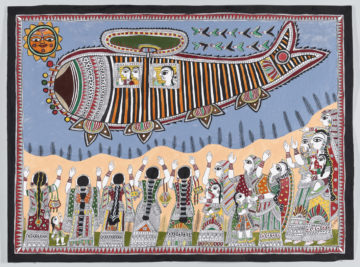
Originally published in the Marina Times San Francisco in October 2018
The Asian Art Museum presents a vibrant, traditional arts movement in Painting is My Everything founded by women of the Mithila region in India. These paintings were originally created with the intention of documenting ritual – religious rituals, household rituals and traditions illustrated with gods and goddesses, ornamented icons of fertility on the walls and floors of dwellings extending back for generations. Born out of the everyday storytelling of families, these artworks that were hidden from public view became a government-lead initiative in 1966, the large murals converted to small paintings created for the tourist trade. This resulted in a life and community changing source of female-generated income where women found their creative voices through paint.
“Painting Is My Everything shares a fascinating story about how art in provincial India can be a vehicle for personal empowerment and a way of keeping local expressive traditions relevant,” says Quamar Adamjee, exhibition organizer and Malavalli Family Foundation associate curator of art of the Indian subcontinent. “The exhibition title is a quote form Dulari Devi, a featured artist whose personal life experience – from hardship to global recognition through her art — mirrors the changes in the practice of painting in the Mithila region.”
A painting from Mithila is instantly recognizable. The stylistic features connect to the caste system in India: High-caste Brahmin designs utilize vivid blues and yellows, clerical-caste Kayastha linework is distinctive for its black and white and occasional red pigmentation, and Dusadh (low caste) painters design patterns from small protective tattoos seen on arms and legs in geometric patterns and floral arrangements. The patterns tell stories of local heroes, deities and personal histories. As artists throughout the area have begun to work together to make these wall paintings commercially available on a smaller scale, the styles have combined. In the process, the caste system is somewhat erased, and in the process the range of subjects is expanded. Everyday life and ritual continues as a theme but added to this are extremely personal experiences involving dreams, the death of a child, and ravel. Commentary on contemporary social and political issues, domestic violence and the environment – the canvases become a snapshot of today.
17 artists included in this exhibit, in sharing their rural stories of village life, communicate modern viewpoints and universal themes. The personal and universal helps to demonstrate Mithila painting as a robust living tradition. The Asian Art Museum will be hosting a week-long artist-in-residence program with Shalinee Kumari, a young, Mithila-based painter who willl lead public artist demonstrations and small-scale workshops in October. Kumari’s recent interests address the position of women in their everyday lives. Inequalities in marriage and education along with the heavy workload of domestic chores and the responsibilities women have to fulfil as well as celebrations of the female friendships feed into this tradition.
A pregnant Cow, 1981, by Shanti Devi is an ink and color on paper image of a cow, weightless and floating in a style reminiscent of Chagall, and with a yet to be born calf hidden inside, impossibly awake with open, curious eyes. Similarly, A Holy Man in the Forest (Shiva as Lord of the Animals), 1981, by Jogmaya Devi is another whimsical painting where the visual plane seems to express inner worlds, in this case a holy man lost in meditation, while smiling animals and geometric shapes swirl around him. Japanese Hippies, 1983, by Gopal Saha is a humorous take on the hippie lifestyle with figures that seem to be doing little more than hanging out. Presented in graphic shapes outlined in ink and brightly colored, the viewer can easily imagine these pictures integrated amongst the activity in a family’s home.
A new installation of Pakistani sound-and-light art from Haroon Mirza’s new installation, The Night Journey, will be on view in an adjacent gallery to Painting Is My Everything and combined with the historic works in the collection galleries presents an opportunity for museumgoers to make connections between the diversity that is contemporary South Asian and diasporia art practices.
Asian Art Museum Director and CEO Jay Xu says “We want our audiences to question how and why artistic traditions continue to evolve and Mithila painting provides a colorful, resonant, deeply humanist voice in this conversation.”